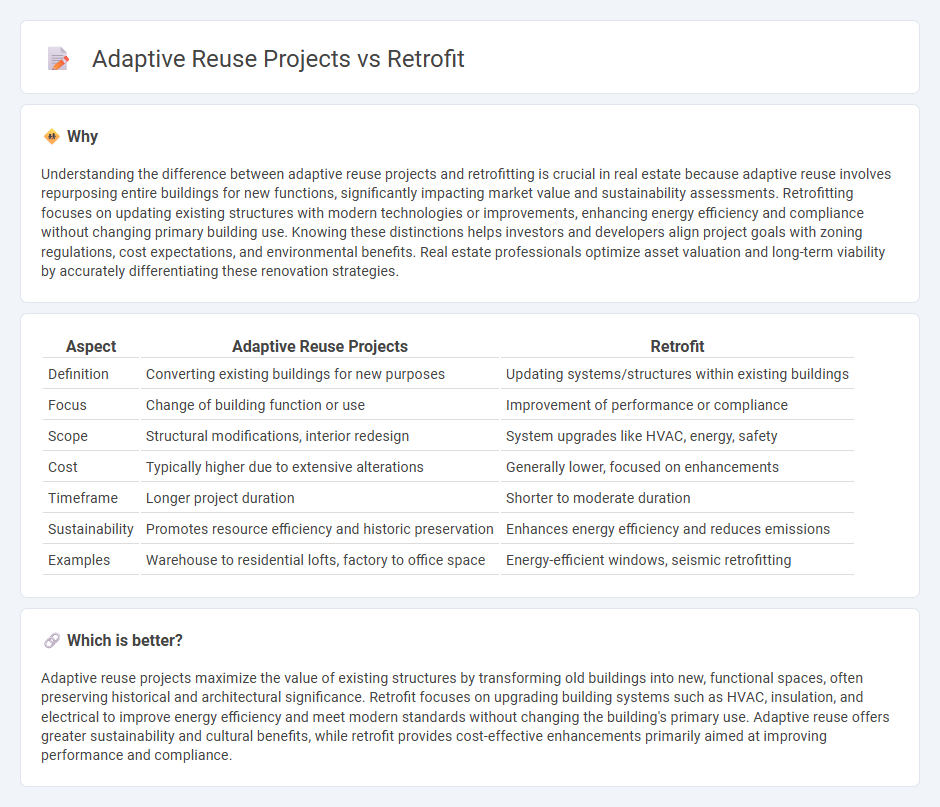
Adaptive reuse projects transform existing buildings for new purposes, preserving historic elements while meeting modern needs. Retrofit involves upgrading building systems and structures to improve energy efficiency, safety, and functionality without changing the original use. Explore how these strategies reshape real estate by blending sustainability with innovation.
Why it is important
Understanding the difference between adaptive reuse projects and retrofitting is crucial in real estate because adaptive reuse involves repurposing entire buildings for new functions, significantly impacting market value and sustainability assessments. Retrofitting focuses on updating existing structures with modern technologies or improvements, enhancing energy efficiency and compliance without changing primary building use. Knowing these distinctions helps investors and developers align project goals with zoning regulations, cost expectations, and environmental benefits. Real estate professionals optimize asset valuation and long-term viability by accurately differentiating these renovation strategies.
Comparison Table
| Aspect | Adaptive Reuse Projects | Retrofit |
|---|---|---|
| Definition | Converting existing buildings for new purposes | Updating systems/structures within existing buildings |
| Focus | Change of building function or use | Improvement of performance or compliance |
| Scope | Structural modifications, interior redesign | System upgrades like HVAC, energy, safety |
| Cost | Typically higher due to extensive alterations | Generally lower, focused on enhancements |
| Timeframe | Longer project duration | Shorter to moderate duration |
| Sustainability | Promotes resource efficiency and historic preservation | Enhances energy efficiency and reduces emissions |
| Examples | Warehouse to residential lofts, factory to office space | Energy-efficient windows, seismic retrofitting |
Which is better?
Adaptive reuse projects maximize the value of existing structures by transforming old buildings into new, functional spaces, often preserving historical and architectural significance. Retrofit focuses on upgrading building systems such as HVAC, insulation, and electrical to improve energy efficiency and meet modern standards without changing the building's primary use. Adaptive reuse offers greater sustainability and cultural benefits, while retrofit provides cost-effective enhancements primarily aimed at improving performance and compliance.
Connection
Adaptive reuse projects and retrofitting are closely connected in real estate by transforming existing buildings to meet modern standards, enhancing sustainability and preserving historical value. Retrofitting involves upgrading structural, mechanical, and electrical systems, which is essential for adaptive reuse to ensure safety, energy efficiency, and compliance with current codes. Together, these processes optimize asset value, reduce construction waste, and support urban regeneration initiatives.
Key Terms
Building Code Compliance
Retrofit projects involve updating existing buildings to meet current Building Code standards, often requiring structural reinforcements and system upgrades to ensure safety and energy efficiency. Adaptive reuse projects repurpose old structures for new uses, facing unique challenges in code compliance related to occupancy changes, accessibility, and historic preservation constraints. Explore detailed strategies for navigating Building Code requirements in both retrofit and adaptive reuse initiatives to optimize project outcomes.
Structural Modifications
Retrofit projects involve upgrading existing buildings with modern materials and technologies to enhance structural performance, energy efficiency, and safety without significant alteration of the original framework. Adaptive reuse projects require extensive structural modifications to repurpose the building for new functions, often involving reinforcement, reconfiguration of load-bearing elements, and integration of contemporary architectural standards. Explore detailed comparisons of these approaches to understand which method best suits your project's goals and constraints.
Historic Preservation
Retrofit projects involve upgrading existing buildings with modern systems while preserving historical elements, enhancing energy efficiency and structural integrity without compromising architectural heritage. Adaptive reuse transforms historic structures for new purposes, maintaining cultural significance and extending the building's lifespan by integrating contemporary functionality. Explore more about how these approaches balance innovation with preservation to protect historic landmarks.
Source and External Links
Retrofitting - The addition of new technology or features to older systems, often used in buildings, vehicles, and infrastructure to improve efficiency or adapt to new requirements.
Retrofit Existing Buildings - A Department of Energy initiative focusing on upgrading the energy performance of commercial buildings through renovations and retrofits.
Retrofit - A type-safe HTTP client for Android and Java, developed by Square, which models REST endpoints as Java interfaces.
 dowidth.com
dowidth.com